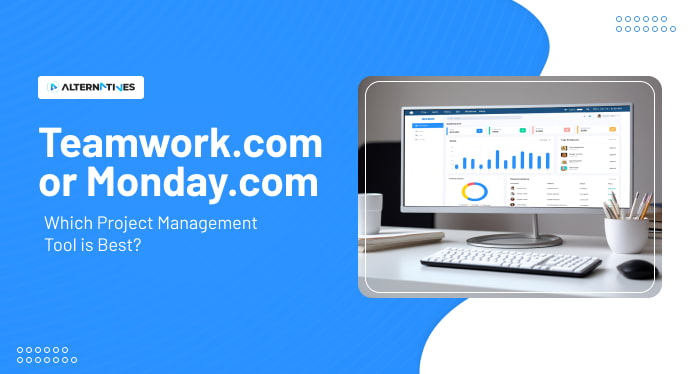Trello Vs. Jira: Which One Is Best For Your Needs?

In today’s ever-evolving work environment, it’s essential to stay on top of the latest project management tools to stay competitive. Trello and Jira are two of the most popular project management tools currently available, but which is the best for your needs? To help you decide, we’ll take an in-depth look at both platforms and compare them side by side. We’ll review user interface, task management, collaboration, project reports, workflows, notifications, integrations, security, and pricing so that you can make an informed decision about which one is right for you.
A Quick Overview of Trello
Trello is a user-friendly project management tool that uses boards, lists, and cards to help teams organize and prioritize tasks. Its intuitive interface makes it easy to create unlimited boards for different projects, ensuring efficient organization. Trello’s features include Custom Fields for task customization, Multi-board guests for streamlined collaboration, and Public board management for transparent communication. Users looking for similar tools as Trello can check out Trello Alternatives.
A Quick Overview of Jira
Jira is a robust project management tool tailored for software development teams, featuring Scrum boards for agile project tracking, customizable workflows, and insightful reports. With drag-and-drop automation and email notifications, Jira streamlines task management and enhances communication. The platform’s flexibility extends to unlimited project boards, offering a versatile solution for teams seeking powerful project management and collaboration tools. Try exploring Jira Alternatives for more similar project management tools.
Features Comparison For Trello Vs Jira
| Feature | Trello | Jira |
| Scrum Board | Offers a visually intuitive Scrum board to facilitate agile project management. | Provides Scrum boards for effective task tracking, allowing teams to work in sprints and visualize progress. |
| Reports and Insights | Provides basic reporting features for project analysis and tracking. | Offers robust reporting and analytics tools to gain deep insights into project performance and team productivity. |
| Customizable Workflows | Limited workflow customization options. | Highly customizable workflows to adapt to various project requirements and processes. |
| Drag and Drop | Lacks native drag-and-drop automation features. | Employs drag-and-drop automation to simplify task management and streamline processes. |
| Email Notifications | Basic email notifications to keep users informed about updates. | Comprehensive email notifications, ensuring teams stay updated on project changes and developments. |
| Unlimited Project Boards | Provide flexibility with unlimited project boards. | Supports unlimited project boards, accommodating a wide range of projects and tasks. |
| Unlimited Boards | Users can create unlimited boards for different projects, enhancing organization. | Offers unlimited boards, allowing for a scalable and adaptable approach to project management. |
| Custom Fields | Incorporates Custom Fields to tailor task details and information. | Utilizes Custom Fields for enhanced task customization, adapting to specific project needs. |
| Multi-Board Guests | Enables collaboration across different projects with Multi-Board Guests. | Facilitates collaboration with multi-board guests, ensuring seamless communication and coordination. |
| Public Board Management | Allows for transparent communication through public board management. | Supports public board management, providing visibility and openness in project communication. |
| Unlimited Workspaces | Offers unlimited workspaces for comprehensive project organization. | Provides unlimited workspaces, allowing for structured organization of projects across teams and departments. |
| User Permissions | Allows customization of user permissions for access control. | Provides robust user permission settings, allowing fine-grained control over who can access and modify project information. |
| Workspace-Level Templates | Offers workspace-level templates for standardized project setups. | Supports workspace-level templates, ensuring consistent project structures and workflows. |
| Pricing | It has four plans Free, Standard, Premium, and Enterprise. For complete pricing check out Trello's pricing | Jira offers four plans Free, Standard, Premium, and Enterprise. The pricing for Jira starts at $8.15 and can go up to $16. |
| Mobile Accessibility | Provides mobile apps for on-the-go access to projects and tasks. | Offers mobile accessibility, ensuring teams can stay connected and productive from anywhere. |
| Time Tracking | Limited time tracking capabilities. | Offers comprehensive time-tracking features to monitor project timelines and team productivity. |
Trello Vs Jira: Features Comparison
1. Scrum Board
Both Trello and Jira offer Scrum features for agile project management. Trello’s Scrum board provides a visual, intuitive interface for organizing and tracking tasks within sprints. It simplifies sprint planning and collaboration. In Jira, the Scrum board is part of a more comprehensive suite, offering advanced customization, detailed reporting, and deeper insights into sprint progress. Jira’s Scrum feature is well-suited for larger, complex projects, providing a more extensive toolkit for teams practicing agile methodologies.
2. Report & Insights
Both Trello and Jira include Reports and Insights features to aid project analysis. Trello offers basic reporting capabilities, providing essential insights into project progress. In contrast, Jira’s Reports and Insights feature is more advanced, offering comprehensive analytics tools. Jira allows for in-depth examination of project performance, team productivity, and other key metrics, catering to the analytical needs of larger teams and enterprises. The difference lies in the depth and complexity of reporting, aligning with the scale and requirements of the respective project management platforms.
3. Customizable Workflows
Trello and Jira both incorporate Customizable Workflows to adapt to diverse project needs. Trello offers a level of customization suitable for simpler processes, allowing users to tailor workflows to their tasks. On the other hand, Jira excels with highly sophisticated Customizable workflow, ideal for intricate project requirements. Jira’s advanced customization capabilities empower teams to create tailored processes, making it well-suited for larger projects with complex workflows and distinct stages.
4. Drag and Drop Automation
In Trello, this feature simplifies the rearrangement of tasks and elements within the boards, streamlining user interactions. Jira takes Drag and drag-and-drop automation further, integrating it with advanced automation capabilities, allowing teams to automate repetitive tasks seamlessly. Jira’s implementation provides a more sophisticated approach, contributing to increased efficiency and automation in managing complex workflows and processes.
5. Email Notifications
Trello and Jira offer Email Notification features to keep teams informed. Trello sends basic email notifications, ensuring users are updated on changes and activities within the boards. Jira, with its more comprehensive Email Notification system, provides detailed alerts tailored to specific events, enhancing communication. Jira’s approach allows for greater customization and control over the information conveyed through email notifications, making it suitable for larger teams managing complex projects with diverse communication needs.
6. Unlimited Project Boards
Both Trello and Jira support Unlimited Project Boards, offering flexibility in organizing tasks. Trello allows users to create unlimited boards for different projects, providing a scalable approach. Similarly, Jira accommodates an unlimited number of project boards, catering to diverse project needs. The difference lies in the overall feature set and scale, with Jira’s unlimited project boards being part of a more extensive suite, suitable for larger enterprises managing numerous projects with varying complexities and requirements.
7. Custom Fields
Trello’s Custom Fields allow users to tailor task details for better organization and categorization. In Jira, Custom Fields play a more extensive role, offering advanced options for detailed task customization. Jira’s feature is suitable for complex projects requiring a higher level of customization and data capture. While both platforms provide flexibility, Jira’s Custom Fields cater to the intricate needs of larger teams managing projects with diverse and specific requirements.
8. Multi-Board Guests
Both Trello and Jira offer Multi-Board Guests features to enhance collaboration across projects. In Trello, this functionality allows users to collaborate seamlessly on multiple boards. Jira’s Multi-Board Guests feature similarly facilitates collaboration, providing users access to various projects. However, in Jira, this is part of a more comprehensive suite, accommodating larger and more intricate projects. Both platforms ensure that collaboration is streamlined, allowing guests to contribute effectively to projects spanning multiple boards.
9. Public Board Management
Trello and Jira both offer Public Board Management for transparent communication. In Trello, users can set boards to the public, allowing easy sharing of information. Similarly, Jira supports Public Board Management, enabling visibility. However, in Jira, this is part of a broader suite, catering to larger projects with extensive communication needs. Both platforms prioritize openness, ensuring that teams can effectively manage and communicate project information with stakeholders, whether it’s in a simpler or more complex project environment.
10. Unlimited Workspaces
Both Trello and Jira support Unlimited Workspaces, allowing for comprehensive project organization. Trello allows users to create unlimited workspaces for organizing and managing various projects. Similarly, Jira accommodates unlimited workspaces, catering to diverse project needs. The difference lies in the scale and complexity. Jira’s Unlimited Workspaces is part of a more extensive suite suitable for larger enterprises managing numerous projects with varying complexities and requirements.
11. User Permissions
In Trello, administrators can customize user permissions to manage access. Jira, with its robust features, provides more extensive options for fine-tuning user permissions, suitable for large teams with diverse roles. Both platforms prioritize security and access control, ensuring that project information is managed securely and that teams can collaborate effectively while maintaining control over who can access and modify critical project details.
12. Workspace-Level Templates
Both Trello and Jira support Workspace-Level Templates for standardized project setups. In Trello, users can create templates at the workspace level, ensuring consistency across projects. Similarly, Jira provides Workspace-Level Templates, allowing for standardized project structures and workflows. The difference lies in the depth and scope, with Jira offering more advanced template capabilities suitable for larger enterprises managing diverse projects with varying complexities, providing a more comprehensive toolkit for standardized project management.
13. Pricing
Trello is a web conferencing and online project management software that offers four plans for different needs: Free, Standard, Premium, and Enterprise. The free plan allows for unlimited meetings with up to 100 participants. The Standard plan costs $5 per user, per month. The Business plan costs $10 per user, per month. The Enterprise plan is available for $17.50/month. Coming to Jira, it offers four plans for different needs: Basic, Standard, Premium, and Enterprise. The Basic plan is free and suitable for small teams with limited project management needs. The Standard plan costs $8.15 per user, per month. The Premium plan costs $16/month.
14. Mobile Accessibility
Both Trello and Jira prioritize Mobile Accessibility, ensuring users can manage projects on the go. Trello provides user-friendly mobile apps, allowing quick access to boards and tasks. Similarly, Jira offers mobile accessibility, enabling teams to stay connected and productive from anywhere. While both platforms facilitate project management on mobile devices, the difference lies in the user interface and features offered, with Trello’s app emphasizing simplicity and ease of use, and Jira’s app providing a feature-rich experience suitable for more complex project requirements.
15. Time Tracking
Both Trello and Jira incorporate time-tracking features to monitor project timelines. Trello offers basic time-tracking capabilities, allowing users to log hours and track progress. In contrast, Jira provides more comprehensive Time-Tracking features, including detailed reporting and analytics. Jira’s advanced time tracking is suitable for larger teams managing complex projects, providing deeper insights into time allocation and productivity.
Trello Vs Jira: Which is Better?
The choice between Trello and Jira ultimately depends on the specific needs and preferences of your team or organization. Trello Reviews often highlight its excellence in simplicity and user-friendliness, making it an excellent choice for smaller teams or projects that prioritize ease of use. On the other hand, Jira Reviews frequently emphasizes its more robust set of features, making it ideal for larger teams or complex projects, particularly in software development. Let's further understand in detail,
Trello – Why it’s Better
- User-Friendly Interface: Trello’s intuitive design makes it easy for users to adopt quickly, ensuring a smoother onboarding process.
- Simplicity and Flexibility: Trello’s simplicity is an advantage for smaller teams or projects, offering straightforward project management without overwhelming features.
- Ease of Use for Non-Technical Users: With a focus on simplicity, Trello is often preferred by non-technical teams or those new to project management tools.
Jira – Why it’s Better
- Advanced Workflow Customization: Jira’s highly customizable workflows are advantageous for larger, complex projects, allowing teams to tailor processes to specific needs.
- Powerful Reporting and Analytics: Jira provides extensive reporting and analytics tools, offering deep insights into project performance and team productivity.
- Scalability for Large Teams: Jira’s comprehensive feature set and advanced functionalities make it well-suited for large teams and enterprises managing complex projects.
Ultimately, the choice between Trello and Jira depends on the specific needs, size, and complexity of the projects or teams. Trello suits those who prioritize simplicity, quick adoption, and flexibility, while Jira is favored for its advanced features, scalability, and robust customization options, especially in larger and more complex project environments.
Frequently Asked Questions
What types of projects are suitable for Trello?
Trello is well-suited for a wide range of projects, especially those with simpler workflows. It’s particularly effective for smaller teams, creative projects, and tasks that benefit from a visual and flexible approach to project management.
Can I integrate third-party apps with both Trello and Jira?
Yes, both Trello and Jira offer integration capabilities, allowing users to connect with various third-party applications and services to enhance functionality and streamline workflows.
How customizable are the workflows in Trello and Jira?
Trello’s workflows are customizable to a certain extent, offering flexibility for task management. Jira, however, provides highly customizable workflows, making it suitable for intricate processes and larger projects.
Is there a mobile app available for Trello and Jira?
Yes, both Trello and Jira provide mobile apps, enabling users to access and manage their projects on the go, ensuring flexibility and productivity.
What are the key differences in pricing between Trello and Jira?
Trello often follows a simpler pricing structure, making it cost-effective for smaller teams. Jira’s pricing may vary based on the specific edition and additional features required, making it suitable for larger enterprises with more complex needs.
How do Trello and Jira handle user permissions and access control?
Both Trello and Jira offer user permission settings, allowing administrators to control access levels. Jira, with its robust features, provides more extensive options for fine-tuning user permissions, which can be advantageous for large teams with diverse roles.
Ultimately, the choice between Trello and Jira hinges on project complexity and team size. Trello’s simplicity and visual approach make it ideal for smaller teams and straightforward projects. In contrast, Jira’s advanced customization, powerful analytics, and scalability cater to larger enterprises with complex workflows. The decision ultimately depends on the specific needs and preferences of the team and the nature of the projects they undertake.



